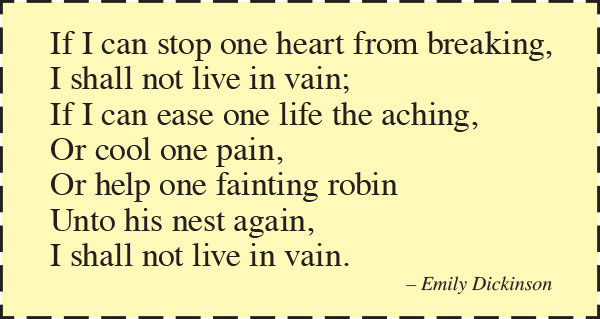The idea is simple: Select a poem you love and carry it with you to share with family and friends. Throughout the day, unfold the poem and read it to yourself or aloud to others. Download pocket-sized poems at poets.org, cut them out and carry them with you. And here’s a poem to cut out to get you started:

Here are more tips for bringing poetry into your children’s lives:
- Simply read fun poems aloud, emphasizing the rhymes or the sounds of the words.
- With older children, introduce different kinds of poetry, such as anthologies, concrete poems, narrative poems, and humorous poems. Show them what poetry can be about–color, nature, dragons, mice, a cornfield, or anger.
- Look at different illustrators’ interpretations of the same poem: for example, Jan Brett’s and James Marshall’s versions of Edward Lear’s “The Owl and the Pussycat.”
- Compare and contrast the two books, even focusing on one small aspect, such as the “pea-green boat.”
- Keep a collection of poetry books in your home. Check out books from your local library.
- Broaden your child’s idea of what poetry can be by introducing anthologies of poetry about a single topic, such as “The Dragons Are Singing Tonight” by Jack Prelutsky, a book of poems all about dragons.
- Show them concrete poetry, or poems that are designed to look like what they are about, by sharing collections such as Joan Bransfield Graham’s “Flicker Flash.”
- It’s often helpful to introduce children to poetry that might inspire them to write their own verse, such as haiku and acrostic poems. Leslie Evans’ “Winter: An Alphabet Acrostic” is a collection that shows children how rich acrostics can be. Share longer narrative poems that tell an entire story, such as Vera B. Williams’ “Amber Was Brave, Essie Was Smart.”

